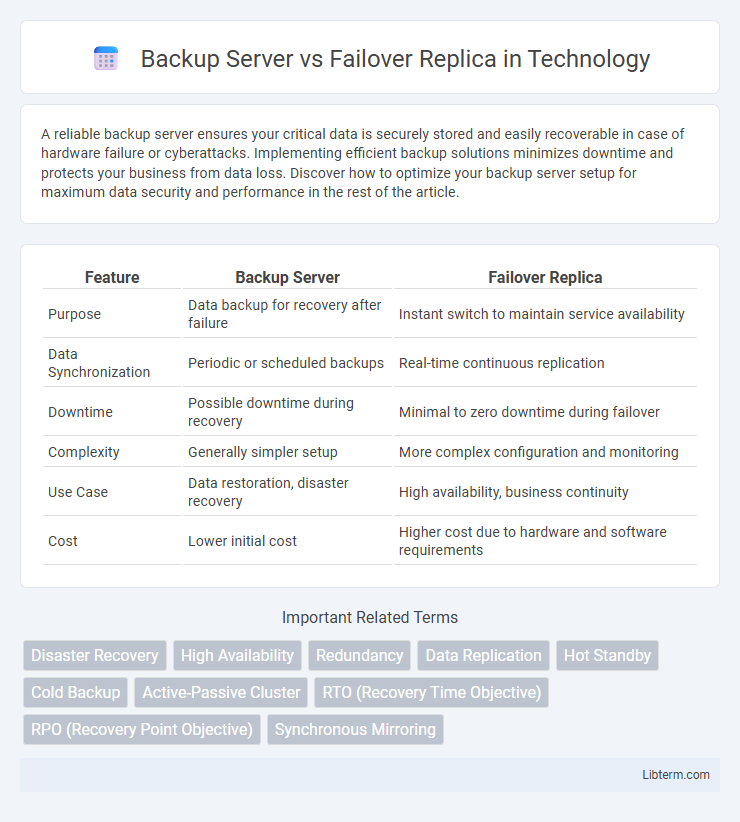A reliable backup server ensures your critical data is securely stored and easily recoverable in case of hardware failure or cyberattacks. Implementing efficient backup solutions minimizes downtime and protects your business from data loss. Discover how to optimize your backup server setup for maximum data security and performance in the rest of the article.
Table of Comparison
| Feature | Backup Server | Failover Replica |
|---|---|---|
| Purpose | Data backup for recovery after failure | Instant switch to maintain service availability |
| Data Synchronization | Periodic or scheduled backups | Real-time continuous replication |
| Downtime | Possible downtime during recovery | Minimal to zero downtime during failover |
| Complexity | Generally simpler setup | More complex configuration and monitoring |
| Use Case | Data restoration, disaster recovery | High availability, business continuity |
| Cost | Lower initial cost | Higher cost due to hardware and software requirements |
Introduction to Backup Server and Failover Replica
A Backup Server stores copies of critical data and system configurations to ensure recovery after data loss or system failure, emphasizing data preservation and restoration. Failover Replica maintains a synchronized copy of an active server that automatically takes over operations in case the primary server fails, prioritizing uninterrupted service and high availability. Both strategies are essential in disaster recovery planning but serve distinct roles in data protection and system continuity.
Defining Backup Server
A Backup Server is a dedicated system designed to store copies of critical data and applications to ensure data recovery in case of primary server failure or data loss. It plays a crucial role in disaster recovery strategies by maintaining up-to-date backups that can be restored to minimize downtime. Unlike Failover Replica, which takes over operations immediately during system failure, the Backup Server primarily serves as a recovery point rather than an active standby system.
What is a Failover Replica?
A Failover Replica is a standby server configured to automatically take over database operations if the primary server fails, ensuring high availability and minimal downtime. It continuously synchronizes with the primary server through real-time data replication, maintaining an identical copy of the database. Unlike a traditional Backup Server, which provides data recovery after failure, a Failover Replica enables seamless service continuity by instantly redirecting client requests to the replica without manual intervention.
Core Differences Between Backup Server and Failover Replica
A backup server stores copies of data at specific points in time to enable restoration after data loss or corruption, prioritizing data recovery. A failover replica continuously mirrors the primary server in real-time or near-real-time, ensuring minimal downtime by automatically taking over during primary server failure. Core differences include the backup server's focus on data restoration and recovery time, while failover replicas emphasize high availability and seamless service continuity.
Use Case Scenarios
Backup servers are primarily used for data restoration and disaster recovery, ensuring data integrity after hardware failures or cyberattacks by maintaining scheduled copies of critical information. Failover replicas provide near-instantaneous switch-over capabilities in high-availability environments, minimizing downtime during system crashes or network disruptions by continuously syncing data in real-time. Use case scenarios for backup servers include long-term data retention and point-in-time recovery, whereas failover replicas are ideal for mission-critical applications requiring continuous uptime and immediate fault tolerance.
Performance and Recovery Speed Comparison
A backup server maintains copies of data and system states for restoration during failures, typically resulting in slower recovery times due to data restoration and synchronization processes. A failover replica offers real-time data replication with automatic switchover, ensuring minimal downtime and superior performance in maintaining continuous service availability. Performance-wise, failover replicas provide faster recovery speed by immediately taking over operations, while backup servers serve as a fallback option requiring longer restoration periods.
Cost Considerations and Resource Requirements
Backup servers typically involve lower resource requirements and upfront costs since they operate intermittently to store copies of data, making them suitable for budget-conscious organizations. Failover replicas demand continuously active resources and higher expenses due to real-time data synchronization and immediate operational readiness, ensuring minimal downtime in critical systems. Evaluating cost considerations between backup servers and failover replicas hinges on balancing initial investments against ongoing operational expenditures and the acceptable level of system availability.
Data Integrity and Consistency
Backup servers store copies of data at specific points in time, ensuring data integrity by preserving static snapshots that protect against corruption and accidental deletion. Failover replicas maintain real-time synchronization with the primary server, providing continuous data consistency and enabling immediate switchover during failures. While backup servers support data restoration from distinct points, failover replicas prioritize seamless data availability and integrity through constant replication.
Best Practices for Implementation
Implementing a backup server requires regular automated backups with secure offsite storage to ensure data integrity and quick recovery in case of failure. Failover replica best practices include maintaining synchronous replication with minimal latency and frequent testing of failover procedures to guarantee seamless service continuity. Combining these strategies optimizes disaster recovery by balancing data protection and system availability.
Choosing the Right Solution for Your Business
Choosing between a Backup Server and a Failover Replica depends on your business's need for data availability and recovery speed. Backup Servers provide point-in-time data restoration, ideal for long-term data protection but with potential downtime during recovery. Failover Replicas offer real-time data synchronization and instant switchover, minimizing downtime and ensuring continuous business operations in high-availability environments.
Backup Server Infographic

 libterm.com
libterm.com